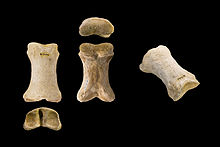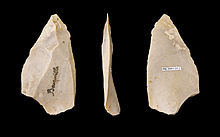- Mousterian
-
The Stone Age
↑ before Homo (Pliocene)
Wild Animals Stone tool
Paleolithic- Lower Paleolithic
Early Stone Age - Middle Paleolithic
Middle Stone Age- Homo neanderthalensis
- Homo sapiens
- Recent African origin of modern humans
- Upper Paleolithic
Late Stone Age
- Heavy Neolithic
- Pre-Pottery Neolithic
- Pottery Neolithic
↓ Chalcolithic Mousterian is a name given by archaeologists to a style of predominantly flint tools (or industry) associated primarily with Homo neanderthalensis and dating to the Middle Paleolithic, the middle part of the Old Stone Age.
Contents
Naming
The culture was named after the type site of Le Moustier, a rock shelter in the Dordogne region of France.[1] Similar flintwork has been found all over unglaciated Europe and also the Near East and North Africa. Handaxes, racloirs and points constitute the industry; sometimes a Levallois technique or another prepared-core technique was employed in making the flint flakes.
Characteristics
 A Quina Mousterian bone tool possibly used to push needles (i.e. a Neanderthal thimble) from France. (This is the Proximal Phalanges from a big toe).
A Quina Mousterian bone tool possibly used to push needles (i.e. a Neanderthal thimble) from France. (This is the Proximal Phalanges from a big toe).
Mousterian tools that have been found in Europe were made by Neanderthals and date from between 300,000 BP and 30,000 BP (from Layer 2A dated 330 ± 5 ka, (OIS) 9 at Pradayrol, France).[2] In Northern Africa and the Near East they were also produced by anatomically modern humans. In the Levant for example, assemblages produced by Neanderthals are indistinguishable from those produced by Qafzeh type modern humans.[3] It may be an example of acculturation of modern humans by Neanderthals because the culture after 130,000 years reached the Levant from Europe (the first Mousterian industry appears there 200,000 BP) and the modern Qafzeh type humans appear in the Levant another 100,000 years later.
It was superseded by the Châtelperronian industry around 35,000-29,000 BP.[citation needed]
Several Mousterian variants are known:
- Denticulate Mousterian
- Ferrassie Mousterian
- Mousterian of Acheulean Tradition (MTA)
- Quina Mousterian
- Typical Mousterian
See also
References
- ^ http://anthropology.si.edu/humanorigins/ha/lemoust.htm The importance of the cave site of Le Moustier lies not in the partial skeleton located there, but in the tool assemblage recovered, which gives the name to the "Mousterian" tool tradition.
- ^ Skinner et al., ʺNew ESR Dates for a New Bone‐Bearing Layer at Pradayrol, Lot, Franceʺ 2007, "Abstracts of the PaleoAnthropology Society 2007 Meetings." PaleoAnthropology 2007:A1-A35
- ^ Shea, J. J., 2003: Neandertals [sic], competition and the origin of modern human behaviour in the Levant, Evolutionary Anthropology, 12:173-187.
External links
- Mousterian Neanderthal Stone Tools
- Neanderthals’ Last Stand Is Traced — New York Times article (Published: September 13, 2006)
Preceded by
MicoquienMousterian
300,000–30,000 BPSucceeded by
ChâtelperronianCategories:- Archaeological cultures
- European archaeology
- Paleolithic
- Lithics
- Middle Stone Age
- Neanderthals
- Lower Paleolithic
Wikimedia Foundation. 2010.

